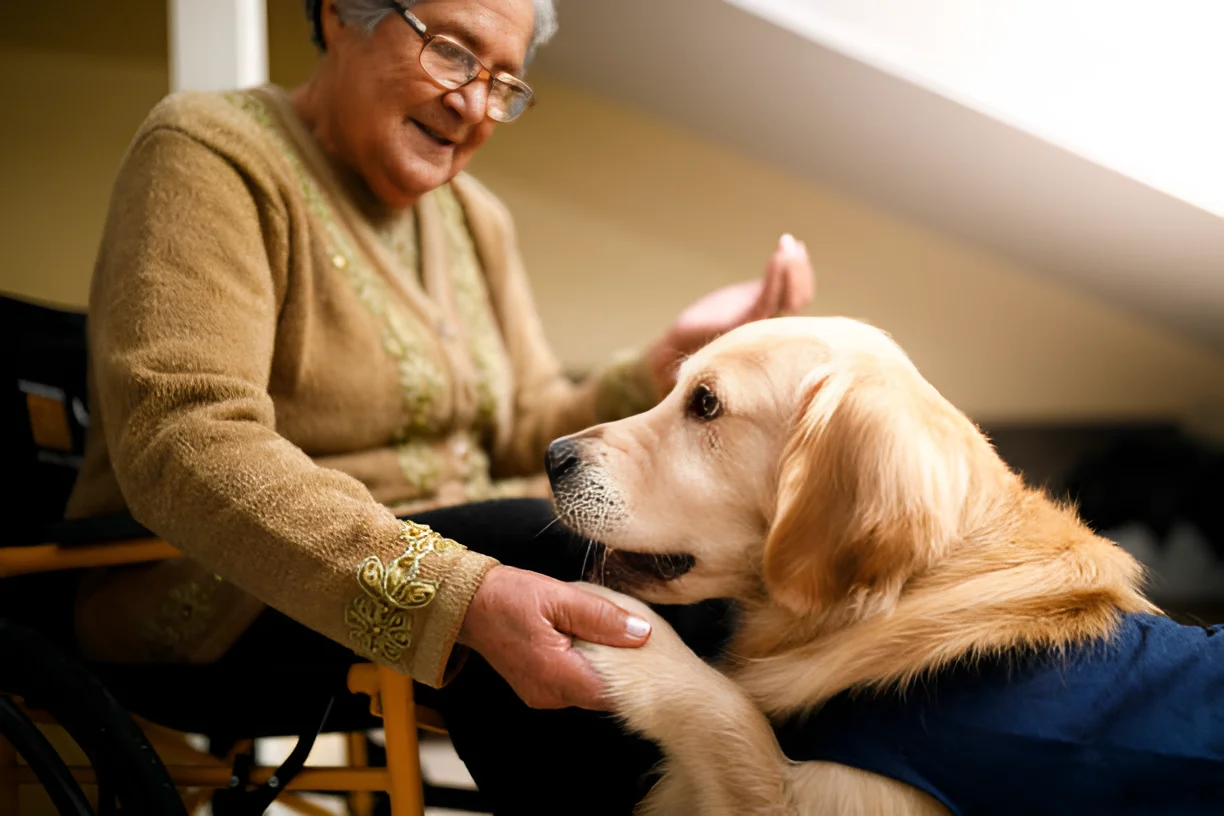Therapy dogs are generally not suited to be guard dogs due to their specialized training and temperament. While both roles are valuable, they require different skills and behaviors that are often incompatible.
Therapy dogs and guard dogs serve distinct and important roles in society. Therapy dogs provide emotional support and comfort to individuals in various settings, while guard dogs are trained to protect property and people. This comprehensive guide will explore the differences between therapy dogs and guard dogs, the training and temperament required for each role, and why combining these roles is generally not advisable.
Understanding Therapy Dogs
The Role of Therapy Dogs
Therapy dogs are trained to provide comfort, affection, and emotional support to people in hospitals, nursing homes, schools, and disaster areas. Their primary function is to improve the mental and emotional well-being of individuals they interact with.
Key Characteristics of Therapy Dogs
- Calm and Gentle Nature
- Therapy dogs must remain calm and composed in various environments, even when faced with loud noises or sudden movements.
- Friendly and Sociable
- They should enjoy interacting with people of all ages and be comfortable being touched and petted.
- Obedient and Well-Trained
- A solid foundation of obedience is crucial for therapy dogs to follow commands and behave appropriately in different settings.
- Adaptable
- Therapy dogs should be able to adapt to new environments and situations without becoming stressed or anxious.
- Healthy
- Regular veterinary check-ups and a healthy lifestyle are essential to ensure the dog can perform their duties effectively.
Understanding Guard Dogs
The Role of Guard Dogs
Guard dogs are trained to protect property and people. They are often used by security companies, law enforcement, and individuals seeking protection. Guard dogs are trained to detect and respond to potential threats, using their presence and, if necessary, physical intervention to deter intruders.
Key Characteristics of Guard Dogs
- Alertness
- Guard dogs must be highly alert and aware of their surroundings to detect potential threats.
- Protective Instincts
- They should have strong protective instincts and be willing to defend their territory and people.
- Confidence and Courage
- Guard dogs need to be confident and courageous to confront potential threats without hesitation.
- Obedience and Control
- Like therapy dogs, guard dogs must be well-trained and obedient to follow commands and respond appropriately in various situations.
- Physical Strength and Agility
- Guard dogs require physical strength and agility to perform their protective duties effectively.
Differences in Training
Training Therapy Dogs
Training therapy dogs focuses on socialization, obedience, and desensitization to various stimuli. The goal is to ensure the dog remains calm, friendly, and approachable in different environments. Key aspects of therapy dog training include:
- Basic Obedience
- Commands such as sit, stay, come, and heel are essential for therapy dogs to follow.
- Socialization
- Exposure to different people, animals, and environments helps therapy dogs remain calm and composed.
- Desensitization
- Therapy dogs are trained to remain calm in the presence of loud noises, sudden movements, and other potentially stressful stimuli.
- Specialized Training
- Depending on their role, therapy dogs may receive additional training to interact with specific populations, such as children or the elderly.
Training Guard Dogs
Training guard dogs focuses on developing their protective instincts, obedience, and physical capabilities. The goal is to ensure the dog can detect and respond to potential threats effectively. Key aspects of guard dog training include:
- Basic Obedience
- Commands such as sit, stay, come, and heel are essential for guard dogs to follow.
- Protection Training
- Guard dogs are trained to recognize and respond to potential threats, including barking to alert their handler and, if necessary, physical intervention.
- Socialization
- While guard dogs need to be socialized, their training emphasizes controlled interactions to ensure they remain focused on their protective duties.
- Physical Conditioning
- Guard dogs undergo physical conditioning to build strength, agility, and endurance.
Why Therapy Dogs and Guard Dogs Have Different Roles
Incompatible Temperaments
Therapy dogs are selected and trained for their calm, gentle, and friendly nature. These traits are essential for providing comfort and emotional support. In contrast, guard dogs are chosen for their alertness, protective instincts, and willingness to confront potential threats. These differing temperaments make it challenging for a dog to excel in both roles simultaneously.
Conflicting Training Goals
The training goals for therapy dogs and guard dogs are fundamentally different. Therapy dog training focuses on socialization, desensitization, and maintaining a calm demeanor. Guard dog training, on the other hand, emphasizes alertness, protection, and physical intervention. Combining these training goals can create confusion and stress for the dog, potentially compromising their effectiveness in both roles.
Legal and Ethical Considerations
There are also legal and ethical considerations to keep in mind. Therapy dogs are often granted access to various public spaces to provide emotional support. Introducing protective behaviors could lead to liability issues if the dog misinterprets a situation and acts aggressively. Additionally, the presence of a guard dog in a therapeutic setting could cause fear and anxiety among individuals seeking comfort.
Can a Dog Be Both a Therapy Dog and a Guard Dog?
Rare Exceptions
While it is generally not advisable for a dog to serve as both a therapy dog and a guard dog, there may be rare exceptions. Some dogs may possess the unique temperament and adaptability to perform both roles effectively. However, this requires careful selection, specialized training, and ongoing assessment to ensure the dog’s well-being and effectiveness in both roles.
Case-by-Case Basis
Deciding whether a dog can serve as both a therapy dog and a guard dog should be done on a case-by-case basis. It is essential to consider the dog’s temperament, training, and the specific needs of the individuals and environments they will serve. Consulting with professional trainers and behaviorists can help determine the best course of action.
Conclusion
Therapy dogs and guard dogs serve distinct and valuable roles, each requiring specialized training and temperament. While it is generally not advisable for a dog to serve as both a therapy dog and a guard dog, there may be rare exceptions. Understanding the differences in training, temperament, and legal considerations can help ensure that dogs are placed in roles that best suit their abilities and provide the greatest benefit to the individuals they serve.
The photo featured below the post headline is Credit: Capuski/istockphoto
I hope you find this post helpful and informative. If Yes’ feel free to share it with your friends!
Frequently Asked Questions
Can a therapy dog be trained to protect its owner?
While therapy dogs can be trained to alert their owner to potential threats, they are generally not suited for protective behaviors. Their training focuses on providing comfort and emotional support, which can conflict with the protective instincts required for guard dogs.
Are there any breeds that can serve as both therapy dogs and guard dogs?
Some breeds, such as German Shepherds and Rottweilers, possess the temperament and physical capabilities to excel in both roles. However, it is essential to assess each dog’s individual temperament and training needs on a case-by-case basis.
What are the risks of training a therapy dog as a guard dog?
Training a therapy dog as a guard dog can create confusion and stress for the dog, potentially compromising their effectiveness in both roles. Additionally, there are legal and ethical considerations, as protective behaviors could lead to liability issues and cause fear and anxiety in therapeutic settings.
How can I determine if my dog is suited for both roles?
Consulting with professional trainers and behaviorists can help assess your dog’s temperament and training needs. They can provide guidance on whether your dog can effectively serve as both a therapy dog and a guard dog.
What should I consider when choosing a therapy dog or a guard dog?
When choosing a therapy dog, look for a calm, gentle, and friendly temperament. For a guard dog, prioritize alertness, protective instincts, and physical capabilities. Ensure the dog receives specialized training tailored to their role.

